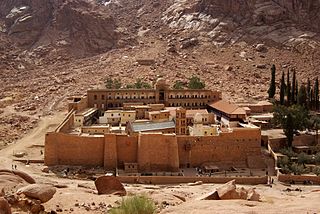Saint Catherine’s Monastery

Saint Catherine’s Monastery, officially “Sacred Monastery of the God-Trodden Mount Sinai”, lies on the Sinai Peninsula, at the mouth of a gorge at the foot of Mount Sinai, in the city of Saint Catherine, Egypt in the South Sinai Governorate. The monastery is controlled by the autocephalous Church of Sinai, part of the wider Eastern Orthodox Church, and is a UNESCO World Heritage Site.
Built between 548 and 565, the monastery is one of the oldest working Christian monasteries in the world. The site contains the world’s oldest continually operating library, possessing many unique books including the Syriac Sinaiticus and, until 1859, the Codex Sinaiticus. A small town with hotels and swimming pools, called Saint Katherine City, has grown around the monastery.
Christian traditions
According to tradition, Catherine of Alexandria was a Christian martyr sentenced to death on the wheel. When this failed to kill her, she was beheaded. According to tradition, angels took her remains to Mount Sinai. Around the year 800, monks from the Sinai Monastery found her remains.
Although it is commonly known as Saint Catherine’s, the monastery’s full official name is the Sacred Monastery of the God-Trodden Mount Sinai. The patronal feast of the monastery is the Transfiguration. The monastery has become a favorite site of pilgrimage.
Manuscripts and icons
Saint Catherine’s Monastery library preserves the second largest collection of early codices and manuscripts in the world, outnumbered only by the Vatican Library. It contains Greek, Arabic, Armenian, Coptic, Hebrew, Georgian, and Aramaic texts.
In May 1844 and February 1859, Constantin von Tischendorf visited the monastery for research and discovered the Codex Sinaiticus, dating from the 4th Century, at the time the oldest almost completely preserved manuscript of the Bible. The finding from 1859 left the monastery in the 19th century for Russia, in circumstances that had been long disputed. But in 2003 Russian scholars discovered the donation act for the manuscript signed by the Council of Cairo Metochion and Archbishop Callistratus on 13 November 1869. The monastery received 9000 rubles as a gift from Tsar Alexander II of Russia. The Codex was sold by Stalin in 1933 to the British Museum and is now in the British Library, London, where it is on public display. Prior to September 1, 2009, a previously unseen fragment of Codex Sinaiticus was discovered in the monastery’s library.
In February 1892, Agnes Smith Lewis identified a palimpsest in St Catherine’s library that became known as the Syriac Sinaiticus and is still in the Monastery’s possession. Agnes and her sister Margaret Dunlop Gibson returned with a team of scholars that included J. Rendel Harris, to photograph and transcribe the work in its entirety. As the manuscript predates the Codex Sinaiticus, it became crucial in understanding the history of the New Testament.
The most important manuscripts have since been filmed or digitized, and so are accessible to scholars. A team of imaging scientists and scholars from the USA and Europe is using spectral imaging techniques developed for imaging the Archimedes Palimpsest to study more than one hundred palimpsests in the monastery library.
Works of art
The complex houses irreplaceable works of art: mosaics, the best collection of early icons in the world, many in encaustic, as well as liturgical objects, chalices and reliquaries, and church buildings. The large icon collection begins with a few dating to the 5th (possibly) and 6th centuries, which are unique survivals, the monastery having been untouched by Byzantine iconoclasm, and never sacked. The oldest icon on an Old Testament theme is also preserved there. A project to catalogue the collections has been ongoing since the 1960s. The monastery was an important centre for the development of the hybrid style of Crusader art, and still retains over 120 icons created in the style, by far the largest collection in existence. Many were evidently created by Latins, probably monks, based in or around the monastery in the 13th century.
Source : wikipedia
https://www.youtube.com/watch?v=xVayV-OhYjU
https://www.youtube.com/watch?v=1hEQAD5dCyY
https://www.youtube.com/watch?v=ja55M3frdlQ
Reviews
https://goo.gl/a4PjmV


Rate this article